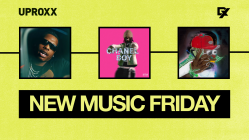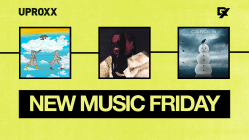In 2003, HipHopDX began the “Industry 101” series. Staff members interviewed various executives in an attempt to provide readers with some transparency about exactly what happens behind the scenes in the music industry. Basic questions such as an A&Rs role or the specific duties of an executive producer were asked. But participants also disclosed how the changing media landscape impacted their jobs and, in some cases, even revealed the strategy behind specific moves. A lot has changed in the 11 years since those initial Q&As: Twitter and Spotify come to mind as examples. This week, HipHopDX will re-launch a special, three-part limited edition of “Industry 101.” And as an indication of just how far technology has taken us and you as the reader, if you’d like to see more of this content, speak with your views. A lot has changed in 11 years, but at the end of the day, the music business is still based on the concept of supply and demand.
For 20 years, Matt Welch has worked around records. A former music store clerk, the Boston local who sometimes still goes by his DJ name “Tall Matt” now works in an office that is to audiophiles what Willy Wonka’s factory is to the sweet tooth. It is sprawling with sealed vinyl, CDs, all colorfully and carefully curated, across the spectrum of genres.
Most of the time, Welch dedicates his hours to Traffic Entertainment—a top distributor of albums ranging from George Benson and Bill Withers, to Madlib and Schoolly D. However, in addition to his daily operation, approximately five years ago, Matt co-founded Get On Down with a handful of friends, also industry peers, who love unearthing and re-presenting their passion. This small division of Traffic has provided the euphoric afterlife to the dying music-buying experience.
With two full time designers, Get On Down not only presses up colored vinyl, gatefold cover-jacketed 45s of early 1990s L.A. Hip-Hop collective The Pharcyde, they package them in a masterfully-designed, handmade music box that would look proud on any shelf or desk. Hand-painted lacquer trophy cases are made to house the emblematic “purple tape” by Raekwon. Vinyl reissues include forgotten posters and stickers that were in store windows or trade magazines. The label has put their stamp on releases ranging from ‘70s Avant-garde composer Arthur Russell, saxophone legend Tom Scott, and over half-a-dozen founding members of Wu-Tang Clan. Having released Joe Mansfield’s book, Beat Box: A Drum Machine Obsession, the imprint is not just limited to CD, vinyl, and cassette—but anything they deem cool, interesting and colorful.
Working with the back catalogs of major and independent labels, as well as increased presence from the musical artists, Get On Down is aiming for loftier projects in their fifth year. Defying the traditional model, the imprint sells direct online, as well as to clothing boutiques, skate shops, and a retailers typically not specializing in albums. Matt Welch recently detailed his careful business model that never trades “cool” for “commerce,” while still growing this homegrown niche operation.
Matt Welch On How Get On Down Curates Limited Edition Projects
HipHopDX: You have been in the record business for a long time, before Get On Down. When and how exactly did the label start?
Matt Welch: It’s hard to pinpoint, exactly. Traffic [Entertainment] is an umbrella company that distributes other companies, so there’s no real brand associated with it. We wanted to make a brand associated and distributed by Traffic, but not necessarily “Traffic.” Traffic could distribute anything—we could distribute frisbees, if they were gonna sell.
For us, we saw a big change in the music industry in 2008—a combination of the [global] financial crisis and the digital market coming to life. A lot of people in physical [music] sales kind of thought of it as a deathblow, and a lot of companies’ strategies were based around licensing and touring and merchandise [rather than sales], as a source of revenue. [In 2003], 50 Cent probably sold 10 million CDs [of Get Rich Or Die Tryin’]; in 2008, I’ll be damned if anybody sold 2 million CDs—which is still an astronomical unit for an independent company like us to wrap our heads around. So we thought, instead of abandoning the physical medium and making what the customer gets as less valuable and less expensive—let’s make it twice as nice. That [thinking] was the genesis.
With that said, I don’t think what we do is applicable to all artists, and I don’t think it would be profitable on a larger scale. The product we develop is not for big-box stores and mall stores. We’re dealing with artists with cult followings. Those followings are very aware of all the idiosyncrasies or details of an artist’s personality. So if you expand on something in the packaging, the hardcore fan is really gonna pick up on that, whereas if you try to apply that to a mass-produced item, the message is going to get lost.
DX: When you were working with these labels before Get On Down, did you get the sense that there were assets available (demo songs, remixes, posters, items)?
Matt Welch: I think the assets have always been available. The people that own the catalog are always interested in monetizing [them]. It’s just that they’re usually not in the position to provide anything, so that puts the work back on [us] as the curator, so to speak, of the project. So you can bring things to people’s attention. Did you know that Big L had hand-lotion [for the 1995 single “Put It On”] as a promo item? There was a [Jeru The Damaja 1993 single] “Come Clean” bar of soap. This is the crap I know because I was working in a record store back when those things came out. That was a big deal to me; I was trying to get my rep to get me that stuff, ‘cause I was a fan.
These days it’s the same. Unless there’s a legal hurdle, [labels are] down to let you pursue that item, but it’s at your expense. The majority of the time, we’re pitching to the people that own the catalogs. If it happens, it happens—and the majority of the time, if it doesn’t happen, it’s for legal reasons. However, from a major label’s perspective, we incur all of the grunt-work. It’s not sexy in the sense of big units sold, but the administrative costs that go into these projects [on the label’s end] probably isn’t that high. The revenue they receive is based on the fact that we do all of the work. In some cases, we’re even getting in touch with the artist and making sure they’re involved. We’re monetizing catalog that they already own and control.
How Get On Down Combines Vintage Assets & Artist Participation
DX: What was Get On Down’s first project?
Matt Welch: The one I like to think of as the first—even if it wasn’t the actual first—was Ol’ Dirty Bastard’s [Return To The 36 Chambers deluxe reissue CD and 2LP] wallet [which included the re-mastered album, laminated food stamp card from the cover, glossy inserts and liner notes]. It was completely my partner Joe Mansfield’s idea and vision. It was outside of the box of anything we were doing at the time, but shed light on what we were trying to do as a company—not saying we’re trying to make wallets [Laughs].
The Raekwon [Only Built 4 Cuban Linx… Purple Cassette Tape Trophy Case] was a big success, and Nas’ [Illmatic 24-karat Audiophile Gold CD Deluxe Edition] was a big success, but instead of flooding the market [since], we took a step back and considered how we can continue to make these special and do projects that push the envelope. We don’t want to be predictable. Our next batch of projects are all very [personal] for us, well thought-out, and the execution is great.
DX: What is one project that you’ve done where an artist was especially helpful?
Matt Welch: After the Raekwon [project], it created an awareness around the company. After that, we did Nas, and then [a 24-karat Audiophile Gold CD Deluxe Edition of Ghostface Killah’s] Ironman, and then a partnership with RZA on [deluxe packaging of Adrian Younge Presents…Twelve Reasons To Die Starring Ghostface Killah]. Since then, we’re cognizant of getting the artist involved.
For example, next year we’re doing a Cypress Hill project. It’s very an awesome, exciting release. I can’t really discuss the details, but I’m very excited. From the beginning, we’re doing it with full support from [DJ] Muggs. I hit him up, and we were on his radar. He was very cool and ready to collaborate. That’s an awesome feeling. Our idea for his baby now his blessing—I know in my heart that those guys in that group are gonna be happy with what we do.
DX: An artist has to be one of the best forms of marketing and promotion on your end too.
Matt Welch: Absolutely. Somebody like Muggs is a stature. These guys are veterans and they get [that], “Yes, some of this property is Sony’s.” Some of the younger guys might not understand it. Artists we work with aren’t taking any vacations because of these projects, but I think they understand that it’s helpful with their legacy. As long as they feel we’re treating it with the respect it deserves, they’re happy, we’re happy.
Get On Down’s Balance Of Brand Integrity & Commerce
DX: As somebody who worked in a record store, you know that rare items have their own mystique. As a business, doing limited runs is probably a difficult balance. How do you navigate that?
Matt Welch: We’re not trying to saturate the market. It’s not like, “We could have sold more of this or that.” It’s water under the bridge. We’re creative people, and we’re business people too—we’ve got to keep the lights on, but we’re not in this to make a quick buck. If you make something and you limit it to 2,000 [units], part of that is us trying to protect our brand, and part of it is just the fact these are expensive to make. We don’t want to over-extend ourselves. We’re not trying to manufacture scarcity. We’re just trying to make what we think the market can bear. We’re not trying to limit things just for the sake of limiting things.
DX: What has been the Get On Down project that you consider your proudest?
Matt Welch: I really like the Arthur Russell [Dinosaur L reissue] project. Musically, [it is] probably not. It’s important to me because it developed my relationship with my screen-printer, which I’m doing a lot of projects with moving forward. So for other reasons besides me sitting down and listening to the record, it meant a lot.
In New York City, a lot of magical stuff happened between 1977 and 1983—everything happening Uptown, and everything happening Downtown, at the same time. There were people like The Clash that were almost blessed enough to be on both sides—or to be able to be hanging out with [graffiti/art legends] Futura 2000 and Fab 5 Freddy, and still be doing shows at Madison Square Garden. 1977 to 1983—not just in a Hip-Hop sense, but where pop culture has gone 30 years after that, it’s just unbelievable. Just six years in one city.
That’s why the Arthur Russell project is so special to me. It opened up doors for me to do other projects that are from that time-period, which will be out next year. Also, the screen-printing: each box has 11 different screen-prints.
We’re all trying to tell different stories with these releases—from the Breaks, to the Reggae, to the Soul. It’s all good music to us. We’re not splitting hairs here going, “[Jazz saxophone legend] Tom Scott and [Dub pioneer] Lee ‘Scratch’ Perry don’t belong on the same label.” It’s probably not supposed to happen; it makes sense to us though. People are buying it though, so I guess it does make sense to other people.
RELATED: Get On Down Discusses Nas “Illmatic” Gold Edition, Offers Giveaway To HipHopDX Readers [News]










I love what Get on Down is doing. I have purchased a couple of their re-issue’s and it’s just nostalgic, classic, Dopeness!!
Nice to see them have the passion and finding creative ways to keep artists legacies alive. #Respect
i bought the ghostface 12 reasons to die. still havent opened the cassette tape yet. i wish i had the money to buy all there stuff. i still love vinyl..
I wish I bought 12RTD from Get Own Down instead of Soul Temple. I pre-ordered it in April and did not get it until January the next year!
I too have not opened my cassette yet as my tape deck is sitting in a closet somewhere collecting dust.